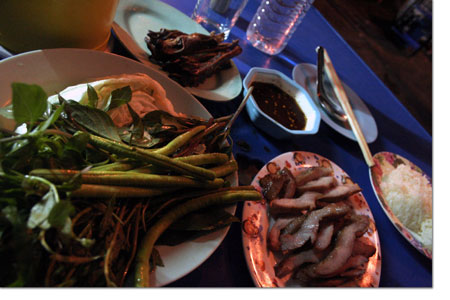| ||
Not to be confused with flavor
by Chef Boy Ari The lukewarm rice porridge in my bowl had zero flavor. None. It was a study in sensory deprivation. “Do you like it?” asked my friend Shortcut. “What’s there to like?” I responded. “There’s no flavor.” “Really?” she asked, with a puzzled look. Now I was the one who was puzzled – puzzled by the fact that she could be so puzzled. She’s Thai, and Thailand is a land of sophisticated culinary understanding. She had to realize the soup was completely devoid of flavor. I pointed to another bowl, in which several chicken feet were floating in a broth. The soup, called “Super Soup,” had a wonderfully complex flavor of sour and spice. “Super Soup,” I explained, “very much flavor.” I then pointed to a plate of delicious greens, English name unknown, looking something like nettles and cooked in a rich seafood sauce. “This one,” I lectured, “very much flavor.” I pointed to the lemon fish, smothered in garlic, chilis and tomatoes. “This one,” I continued, “amazing flavor.” Then I pointed to the rice porridge. “But this one,” I said, gesticulating impotently as I searched for the right words. “This one…” “Not flavor,” Shortcut offered. “Yes, exactly,” I said. “Not flavor.” Despite this hint of agreement, my point still seemed lost on Shortcut, who shrugged and continued adding spoonfuls of the various incarnations of flavor to her bowl of not-flavor. After a few minutes, the lemon fish had charmed me into eating past the point of reasonable chili intake. Too many pepper parts had entered my mouth, which was on fire. I drained my ice water, as if that would help, and then in desperation I took a big spoonful of not-flavor. It absorbed the heat like a sponge, stopping the pain in my mouth like deep sand stopping a runaway truck. The pain was gone. “Now maybe you like the not-flavor,” Shortcut said, rubbing it in. With that, I began to understand. I realized that this combination of flavor and not-flavor is a Thai form of what I call “co-munching,” the act of deliberately chewing different foods together. A bite of pickle with your sandwich? You’re co-munching. A sip of wine while you chew a piece of steak? Co-munching. Normally one co-munches to add flavor, but in this case the co-munching was to temper flavor. Too much flavor plus not enough flavor equaled the right amount of flavor. The next night, eating on a street corner, my roast duck came with a bowl of rice, a bowl of sauce and a plate of vegetables: cabbage, string beans, basil and other herbs. Only the beans were lightly steamed, the rest of the vegetables were raw, with absolutely no seasoning or dressing. Like the not-flavor in a bowl, these veggies were a bold and deliberately bland counterpart to be co-munched with the big flavor of the duck and sauce. Chewed together, the flavor of the duck brought out the flavor of the veggies. Thai people are experts at combining the various items on the table into perfect mouthfuls. With fork or chopsticks, they carefully select and maneuver the desired items onto a spoon, which is delivered to the mouth. This arranging could be considered the final act of the “cooking” process, as the proportions of the various condiments and side dishes create the personalized final flavor. It isn’t news to me that Thais are world-class co-munchers and condiment artists – I’ve seen tables set with as many as eight condiments and co-munching items. But the idea of co-munching with something that seems purposefully bland … this was news. And you know how it is once an idea is planted in your head: you see it again and again. On the first day of Chinese New Year, I joined my friend Foi for steamed chicken. If that sounds bland, you’re right. The two sauces she served it with, meanwhile, were so strong and spicy they were barely edible. And guess what? The potent sauce plus the not-flavor chicken equaled perfect flavor. We pulled apart the chicken with our fingers and poured the sauces on and it was fabulous. Even the plain white rice that comes with just about every meal can be considered a “blanding agent,” although most Thais might disagree. The flavor of rice, especially Thai jasmine rice, is subtle but definitely there. In an effort to eat as many interesting things as possible, I sometimes tried to forgo the rice, in order to leave room in my belly for less pedestrian offerings. But these attempts were usually vetoed by the servers, who’d look at me like I was crazy and bring me rice anyway. Eventually I gave up and ate my food the way the Thais intended. Now that I’m used to it, I wouldn’t eat it any other way. Like Shortcut, Foi and the rest of Thailand, I carefully arrange, doctor and personalize my bite-sized combinations of flavor, not-flavor, and everything in between, rice included, and co-munch Thai-style. •
|


